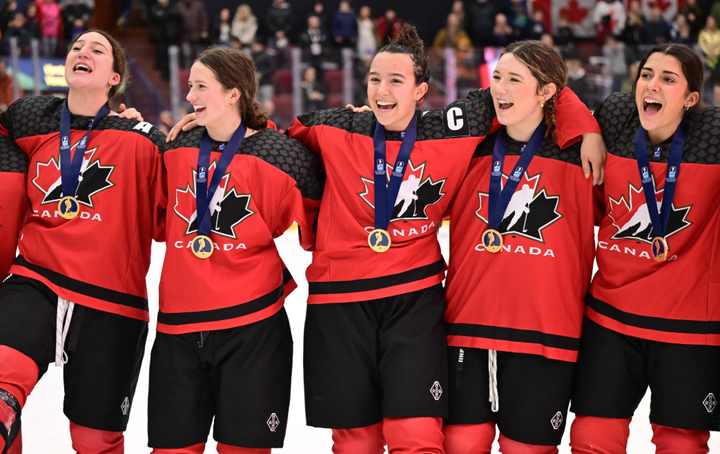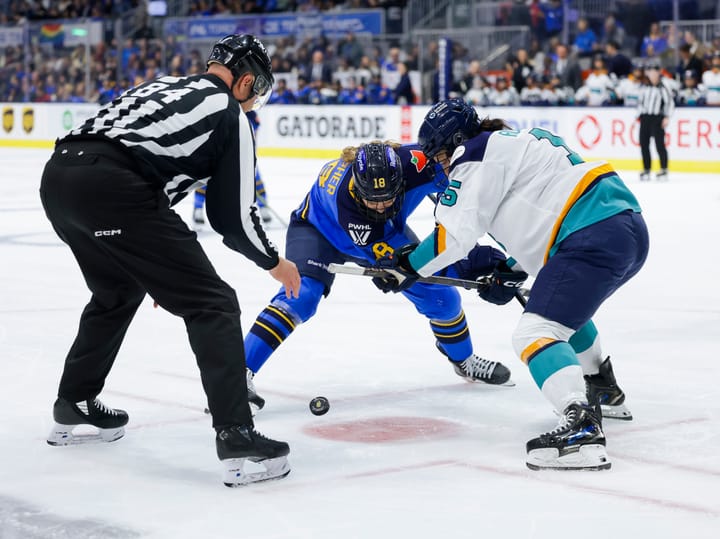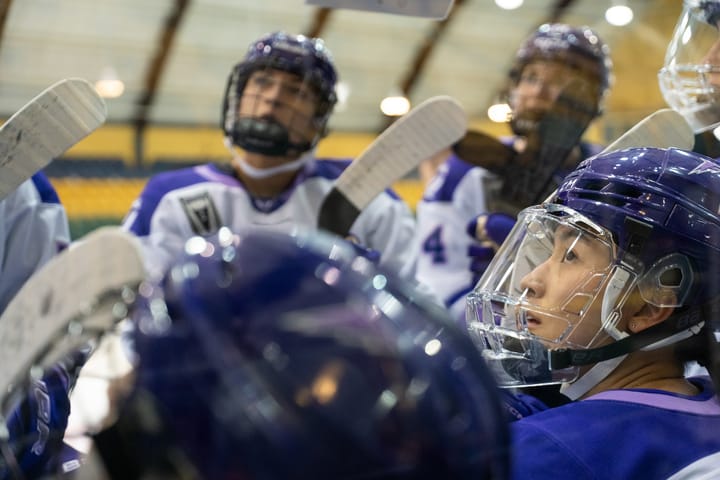More than just a game: Women’s hockey and mental health
Three players open up about the importance of mental health in women’s hockey
Editor’s Note: The contents of this article discuss mental health and suicide. These are very sensitive issues that can be very triggering for a lot of people — read at your own discretion.
Some hockey players are able to skate by without focusing on their mental health beyond what’s necessary to their game. They wake up and eat and train and perform their jobs and sleep with little to no difficulty. Others — like Daron Richardson — struggle to cope with the pressure that comes with being an athlete.
For many hockey players, including those performing at the collegiate, professional, and international levels, that pressure can build and turn into an insatiable monster that many athletes have to fight to suppress. Everyday activities turn into a battle and the will to live morphs into the will to simply make it through each day.
In 2010, 14 year old hockey player Daron Richardson committed suicide. In the wake of her death and in the midst of their grief, her parents created an initiative called Do it For Daron — a small foundation initially created to honor Daron’s memory and spread awareness for mental health.
DIFD has grown exponentially since then, blossoming into a widespread movement that is challenging the status quo. Supported by hockey players and their communities across North America, DIFD is now a beacon of hope for teens and young adults struggling with their mental health.
In 2017, the CWHL’s Calgary Inferno hosted the first annual Start the Spark game, featuring purple jerseys to commemorate Daron. The NWHL’s Boston Pride followed suit in 2018, and have made the evening an almost annual event in the years since. Several collegiate hockey programs across the United States and Canada, including Quinnipiac University in Connecticut and Union College in New York, host annual games with the intent of raising money for DIFD and mental health.
The hockey community has come together at all levels under the hashtag #WeAllSkateTogether to honor Daron’s memory and support the mission her parents created — to “inspire conversations, raise awareness, and transform youth mental health.”
Resources offered by initiatives like DIFD aim to alleviate some of that pressure, and give athletes an outlet and someone to turn to in times of crisis. The problem is that many athletes — and many people in general — are afraid to reach out. Especially in a culture like hockey, where toughness and unwillingness to bend or break is applauded and any sign of weakness is exploited, many players struggle with the very idea getting help for something they believe to be a non-issue.
“Everyone in sports is expected to be these super tough athletes,” said Grace Markey, a junior forward on Quinnipiac’s hockey squad, in an interview with The Ice Garden. “That’s kind of a mask that a lot of people think they have to put on.”
When so much of an athlete’s success is tied to their physical performance and imperturbable exterior, their mental health is often pushed to the back burner and gets left to simmer unchecked. The buildup of frustration and agony can be devastating for anyone, but when combined with the pressure of preserving a mandatory academic standard, pushing your body to the limit day in and day out, and somehow still maintaining your composure, it can result in devastating consequences.
That’s part of why Markey is so vocal about bringing initiatives like DIFD to college hockey programs like her own at Quinnipiac. “We just like to represent something that’s bigger than ourselves,” says Markey, who, according to assistant coach Amanda Mazzotta, was instrumental in revitalizing the Quinnipiac’s involvement with DIFD. “We’re just playing a game but it’s great that we can also spread mental health awareness as we do that.”
“We’re just playing a game but it’s great that we can also spread mental health awareness as we do that.”
On Dec. 7, 2019, Quinnipiac hosted their second ever Do it for Daron Mental Health Awareness game at home against Cornell. Despite the Bobcats’ loss that night, Mazzotta commends Markey for her role in spreading the message of DIFD to her teammates and the Hamden community. “College sports gives these young people an avenue to create awesome change,” she says. “It gives our players a platform to reach more people ... so the fact that they’re as busy as they are and the fact that they’re excited to raise money for awesome organizations, I think that’s huge.”
The NWHL’s Kelsey Neumann shares Markey’s enthusiasm for programs that raise awareness for mental health.
While the Beauts have yet to host their own DIFD game (something Neumann says she would love to see in the future), the Beauts net minder is apart of a different initiative. She’s part of the the Goalie Guild’s “Lift the Mask” program, which aims to provide “mental health and performance support and resources for the goalie community.” Neumann decided to get involved with Lift the Mask for a variety of reasons, but mostly because, she says, “Mental health has been very important to me; it is something I have struggled with throughout my life. Growing up, mental health wasn’t talked about.”
Though mental illness has no preference for position, Mazzotta — who played goalie during her tenure at Cornell — agrees with Neumann that playing goaltender can be pretty rough on one’s mental health. “As a goalie, you’re kind of on your own island for 20 minutes at a time,” says Mazzotta. “You do have to be resilient and positive with yourself in terms of your self-talk.” That’s why initiatives like Lift the Mask are so pivotal.
Lift the Mask, however, is just one pivotal resource for hockey players aiming to provide mental health awareness and emotional support for its members. While many college athletic programs have built-in resources like psychologists or counselors, some don’t — and that’s where other members of the team’s support staff step in and help fill that role. For Markey, that pseudo-counselor was the program’s athletic trainer, Carrie Gaydos, who Mazzotta was also quick to praise. She’s like a “mom away from home” for many of the players, and one of the first people Markey expects she, along with most of her teammates, would turn to in a crisis.
Some athletes even have personalized sports psychologists, like Kelsey Neumann, who started seeing a professional while she was a goalie at SUNY Plattsburgh. “I now work with a great sports psychologist who has truly helped me on and off the ice,” says Neumann. “I also have people on the [Beauts] staff that I feel confident talking to in addition to my sports psych when I feel like I am struggling.”
Not every player or program has these kinds of resources for their athletes, nor does every professional organization. At such a pivotal point in women’s hockey history, it’s imperative that all athletes have more — and more adequate — mental health resources on hand in case the need arises; after all, it’s better to be over-prepared than to be caught off guard.
Moving forward, it’s important that international organizations like USA Hockey and Hockey Canada set the precedent for professional leagues when it comes to mental health initiatives. Rather than just tweet #BellLetsTalk and sharing the story of a singular program member, leagues and organizations need to make sure they’re doing right by the athletes they serve, and making sure they stay healthy — both physically and mentally.
When it comes to these big organizations, the three athletes have some ideas.
For one, trusted adults can be a great help, but the consequent hovering from those individuals, whether it’s coaches, trainers, or counselors, can be overwhelming when you first reach out for help. That’s why Markey suggests a tip line or online chat with a campus or registered professional with the added component of anonymity.
“A lot of people think that there’s a negative connotation with mental health,” she says, and adds that a lot of people view the part of them that’s suffering as a weakness that needs to be concealed from those around them, including teammates and coaches. Anonymity provides a great alternative to the shame that some athletes experience after asking for help from a coach or member of their program’s support staff.
While anonymous chat lines can be a great temporary fix, what happens when you’re constantly struggling and you need someone to turn to for long term help? Sophia Shaver, who spent the 2019-20 season competing with the PWHPA, has a few different ideas for athletes in particular.
“Most of us revolve our lives around our sport,” says Shaver, “so when we are struggling with our mental health and are unable to perform at our best we tend to think we’re failing as a person.”
Coaches and support staff can highlight team counselors, psychologists, and trainers as much as they want, but a lot of students and athletes are hesitant about talking to adults they don’t know about feelings they don’t understand. There’s also the additional fear that the staff touting these resources would personally never use them or believe in their usefulness, or that they’re only making their athletes aware of said programs and resources out of obligation.
“It’s not as effective to hear about these resources from leaders of an organization because it makes them seem intimidating and less accessible to athletes. It doesn’t create an inviting environment,” says Shaver, further emphasizing the importance of leaders on the team raising awareness for these resources instead of the adults, like captains or alternates. When peer leaders present these methods and share they, personally, have benefitted, athletes are more likely to reach out and get the help they need because their friends and teammates have vouched for its effectiveness.
If you know your friends or teammates are hurting but they aren’t receptive to emotional confrontations, Shaver recommends the path her own teammates took — small, random acts of kindness to brighten her day. “Texts to check in, little notes in my dress-down stall at the rink, and plans to do fun things reassured me that they were there for me when I was ready to open up,” she says. “The best way to be there for someone is to show them that they’re not alone and to let them open up to you in their own time.”
The biggest factor in improving mental health awareness, emphasized by all three, was the destigmatization of asking for help. Programs, resources, and initiatives are all just lip service unless we dismantle the idea that athletes need to be tough and strong in the face of every adversity, and that starts from within. “Leagues and collegiate programs could help their athletes by having discussions about mental health for starters,” says Neumann.
Shaver echoed similar sentiments. “You can have all the programs and resources in the world to help athletes, but when there’s such a large stigma surrounding mental health, getting those athletes to reach out for help is the hard part,” she says.
That’s why programs like Bell Canada’s #BellLetsTalk and event nights like Quinnipiac’s DIFD game are so important. Shaver says that sharing your own story on #BellLetsTalk Day can have a broader impact than just hitting retweet on every single hashtag. “As athletes, it would be great to see people open up about the mental battles they face while playing their sport.
“I bet people would find out we all have a lot more in common than we’d think.”





Comments ()